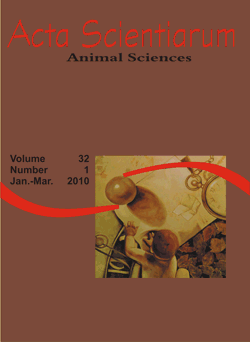<b>Linearization of the titration curves for determination of buffering capacity of feed fiber in a wide pH range</b> - DOI: 10.4025/actascianimsci.v32i1.5384
Keywords:
titratable acidity, buffering capacity, neutral detergent fiber, physical-chemical property, linear measure
Abstract
A method for linearization of titration curves and its application to determine the buffering capacity (BC) of neutral detergent fiber (NDF) from 13 feeds and their mixtures was evaluated. Individual data from 2 essays, including samples of white oat, black oat, ryegrass, red clover and white clover (essay 1), and samples of corn, soybean meal, wheat straw and mixtures of these five feeds (essay 2). Titration was performed just to the pH 2.0. The titratable acidity was measured as the amount of HCl needed (mEq g-1 NDF) to reduce the initial pH of the solution down to 4.0, 3.0 and 2.0, and the linear buffer (LB) measure were determined as the inverse of the slope of the linear regression between linearized pH, calculated as EXP (1 pH-1), and the accumulated HCl in each interval. The transformation presented satisfactory fitting to linear regression for all materials evaluated, with r2 higher than 0.85 and standard error residual lower than 0.059. A positive correlation between TA and LB evaluated in the different ranges of pH was obtained. Unlike TA, the LB method makes it possible to obtain the BC as a single linear ratio, valuable for every pH interval from 8.0 to 2.0.Downloads
Download data is not yet available.
Published
2010-02-24
How to Cite
Oliveira, J. M., Bockor, L., Eggers, M., Gierus, M., Dittrich, J. R., & Warpechowski, M. B. (2010). <b>Linearization of the titration curves for determination of buffering capacity of feed fiber in a wide pH range</b> - DOI: 10.4025/actascianimsci.v32i1.5384. Acta Scientiarum. Animal Sciences, 32(1), 55-61. https://doi.org/10.4025/actascianimsci.v32i1.5384
Issue
Section
Ruminant Nutrition
DECLARATION OF ORIGINALITY AND COPYRIGHTS
- I Declare that current article is original and has not been submitted for publication, in part or in whole, to any other national or international journal.
The copyrights belong exclusively to the authors. Published content is licensed under Creative Commons Attribution 4.0 (CC BY 4.0) guidelines, which allows sharing (copy and distribution of the material in any medium or format) and adaptation (remix, transform, and build upon the material) for any purpose, even commercially, under the terms of attribution.
Read this link for further information on how to use CC BY 4.0 properly.
0.9
2019CiteScore
29th percentile
Powered by 








































